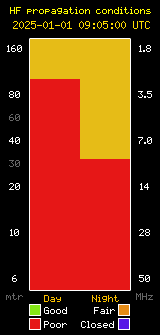
Well, I have made it into another year, and started off to see what I could work during 2024.
I have not set any targets yet, but time will tell.
Thanks to Ken providing a replacement for my duff high power ATU. I have dabbled a bit on several bands using Voice, CW and data. I reset the counter for the 60m band and to date have contacted over 60 DXCCs. Last year I worked data from August to the year-end with a count of 98, and filled two logbooks.
On the propagation front I have enough data to guess at least part of the mechanics of this band. Local contacts out to about 500 miles make up the bulk of contacts and are unlikely to be ground wave, more likely NVIS from my low-level dipole. Using the grid square map, I have worked just about all squares out to 1200 miles, so a second hop of NVIS or a regular F2 reflection could be the path.
I have now enough confidence to guess that the elusive DX I mentioned last year is appearing to be a form of grey-line. Usually we expect to work the sunrise/sunset track to DX stations for an hour or so. 60m seems to be different. The contacts seem only to last a couple of minutes at most and not only use the SR/SS route but also SR or SS to darkness. My daytime is generally dead for most days but as darkness falls the band opens - not only to the locals but also the DX that is already, or still, in darkness. During our late dark evenings, contacts can be made with sunrise stations to the far east and to sunset ones in the far west.
It's all very strange to me, and I hope that someone reading this can shed some light on what is really going on!

One unfortunate trait I have noticed is 'out of band' working. Here in the UK, we are strictly limited to keep within our allocated frequencies. On 60m FT8 the operating dial setting is 5.357 MHz. The upper edge of our band slot is 5.358, so, the highest audio tone we are allowed to transmit is 1 kHz (5.357 +.1 = 5.358).
Unfortunately, far too many UK calls can be seen well above this limit, having said that, when I started to use this band, I did make the same mistake and got 'shouted' at for my troubles. Ironically this was from a station that was himself too high!
At a recent ham-meet I enquired of an expert why my 60 metre contacts were not appearing in some databases? The answer is that, as yet the ARRL have not recognised this band for scoring DXCCs. Their reasoning is that there are still a number of countries that have yet to allow amateurs on this band so until then that would not represent a fair playing field!
Until next time,
73's
Chris G4ZCS



